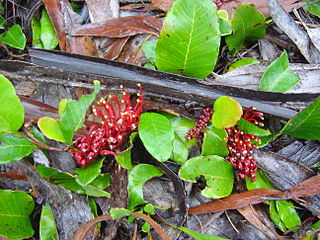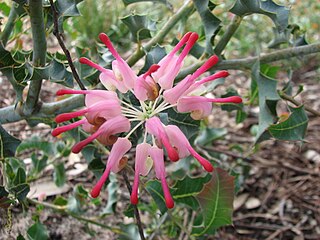
Grevillea buxifolia, commonly known as grey spider flower, is a species of flowering plant in the family Proteaceae, and is endemic to New South Wales, Australia. It is an erect to spreading shrub with elliptic to egg-shaped leaves, and woolly-hairy clusters of rust-coloured to fawn flowers.

Grevillea guthrieana, commonly known as Guthrie's grevillea, is a species of flowering plant in the family Proteaceae and is endemic to New South Wales. It is a spreading shrub with oblong leaves and clusters of two to six green and maroon flowers.

Grevillea agrifolia, the blue grevillea, is a species of flowering plant in the family Proteaceae and is native to the north of Western Australia and parts of the Northern Territory. It is a shrub or tree with narrowly oblong leaves with the narrower end towards the base, and creamy-yellow flowers.

Grevillea laurifolia, commonly known as laurel-leaf grevillea, is a species of flowering plant in the family Proteaceae and is endemic to New South Wales. It is a prostrate, trailing shrub with egg-shaped, heart-shaped or round leaves, and clusters of reddish to deep maroon flowers.

Grevillea mollis, commonly known as soft grevillea, is a species of flowering plant in the family Proteaceae and is endemic to a restricted area of north-eastern New South Wales. It is an open, spreading shrub with oblong to elliptic leaves and loose clusters of bright scarlet red flowers.
Grevillea hockingsii is a species of flowering plant in the family Proteaceae and is endemic to south-eastern Queensland. It is an erect shrub with oblong to narrowly elliptic leaves and clusters of reddish-pink flowers.
Grevillea cyranostigma, commonly known as Carnarvon grevillea or green grevillea, is a species of flowering plant in the family Proteaceae and is endemic to the Carnarvon Range and adjacent areas of central Queensland. It is a spreading shrub with woolly-hairy to silky-hairy branchlets, narrowly oblong leaves, and pale green flowers.
Grevillea kedumbensis is a species of flowering plant in the family Proteaceae and is endemic to a restricted locale in the Great Dividing Range in central New South Wales in Australia. It is a twiggy shrub with narrowly elliptic to egg-shaped leaves with the narrower end towards the base, and clusters of hairy green to cream-coloured flowers.
Grevillea obtusiflora is a species of flowering plant in the family Proteaceae and is endemic to a small area of eastern New South Wales. It is a low, spreading to erect shrub with many stems, narrowly elliptic to oblong or linear to narrowly egg-shaped leaves with the narrower end towards the base, and pinkish-red and cream-coloured flowers with a red style.

Grevillea exposita is a species of flowering plant in the family Proteaceae and is endemic to the south-west of Western Australia. It is a dense, spreading shrub with mostly oblong to narrowly elliptic leaves and clusters of bright red and white flowers.

Grevillea evanescens is a species of flowering plant in the family Proteaceae and is endemic to the south-west of Western Australia. It is an erect to spreading shrub with oblong to elliptic leaves and clusters of pale to bright red and cream-coloured flowers.

Grevillea insignis, commonly known as wax grevillea, is a species of flowering plant in the family Proteaceae and is endemic to the south-west of Western Australia. It is an erect, bushy shrub with more or less oblong leaves with seven to seventeen sharply-pointed, triangular teeth, and more or less spherical or cylindrical clusters of cream-coloured flowers ageing to pink.

Grevillea masonii, commonly known as Mason's grevillea, is a species of flowering plant in the family Proteaceae and is endemic to a restricted area of New South Wales. It is a low-growing shrub with egg-shaped to elliptic leaves, and red and green flowers with a green style.

Grevillea macleayana, commonly known as Jervis Bay grevillea, is a species of flowering plant in the family Proteaceae and is endemic to south-eastern New South Wales. It is a spreading shrub with egg-shaped to elliptic, sometimes lobed leaves, and greenish or greyish flowers with a pink to red style.
Grevillea granulifera is a species of flowering plant in the family Proteaceae and is endemic to eastern New South Wales. It is a shrub with narrowly elliptic leaves and clusters of pinkish-red and creamy-white flowers.

Grevillea coccinea is a species of flowering plant in the family Proteaceae and is endemic to the south of Western Australia. It is a low-lying or sprawling shrub with narrowly wedge-shaped to linear leaves and white, cream-coloured, and red or yellow flowers.

Grevillea delta is a species of flowering plant in the family Proteaceae and is endemic to restricted area in the south-west of Western Australia. It is a bushy, spreading shrub with hairy branchlets, divided leaves with linear lobes, and groups of red flowers with a red, green-tipped style.
Grevillea punctata is a species of flowering plant in the family Proteaceae and is endemic to a restricted part of the South West region of Western Australia. It is a shrub with oblong to elliptic leaves and scarlet flowers.

Grevillea pythara, commonly known as Pythara grevillea, is a species of flowering plant in the family Proteaceae and is endemic to a restricted part of the South West region of Western Australia. It is a low, suckering shrub with linear to narrowly elliptic leaves and small groups of red flowers.

Grevillea pluricaulis is a species of flowering plant in the family Proteaceae and is endemic the Northern Territory in Australia. It is an erect shrub with elliptic leaves, the edges wavy, and light green to apricot-coloured or creamy brown flowers with a pale orange-apricot to pink style.















